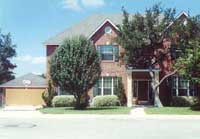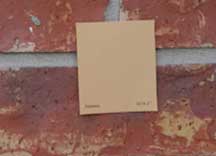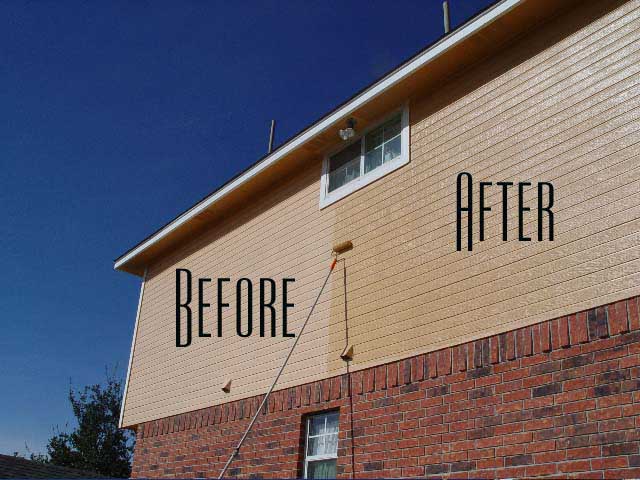USRW Home
theHOAprimer
The House On Ridge River
The following dispute between a homeowner and
the Board of Directors involved house painting. More specifically, it dealt with
color - what colors are acceptable, and who has the right to choose those
colors.
The House Painting
The homeowners painted their house in early April
of 2000. The color was matched to the accent color in the brickwork. The work
was completed on April 11, 2000. Nine months after the house was painted, the
Board of Directors sent the homeowners a letter stating that they had written
new rules governing house painting and that the homeowners were now in violation
of those new rules by
painting their house a color that was not approved by the Architectural Control
Committee (ACC). The first notice of this change was published in the Oct. 2000
edition of the neighborhood newsletter.
matched to the accent color in the brickwork. The work
was completed on April 11, 2000. Nine months after the house was painted, the
Board of Directors sent the homeowners a letter stating that they had written
new rules governing house painting and that the homeowners were now in violation
of those new rules by
painting their house a color that was not approved by the Architectural Control
Committee (ACC). The first notice of this change was published in the Oct. 2000
edition of the neighborhood newsletter.
"Architectural Control Committee -
Policy Change
The Architectural Control Committee
(ACC) has been requested to review it's (sic) present policy of allowing
homeowners to paint the exterior of their houses any color (or colors) they
choose. At the urging of the Board of Directors, the ACC is now requiring
homeowners who wish to paint/repaint the exterior of their houses to submit
their color selection(s) to the ACC PRIOR to beginning work."
Out on the Ridge, October 2000
The homeowners pointed out that the phrases
"present policy," "now requiring," and the publication date
(seven months after the house was painted) indicated that they acted in complete accordance with the regulations and practices as the Board of
Directors defined them in April of 2000. By the BOD own admission, house
painting did not require ACC approval in April 2000. They contended that their rights were grand
fathered. The Board refused to honor their grand fathered status.
The Clause
The Board defended their right to dictate color
choices with a clause from article VI of the CC&Rs They quoted
the clause as follows:
"No building, fence, wall, outbuilding
or other structure or improvement shall be erected, altered, added onto,
placed or repaired on any lot in the subdivision until the plans and
specifications shall first submit to the ACC a complete set of plans and
specifications for the proposed improvements...."
This clause, they said, could be interpreted to
mean anything they want it to mean. The homeowners read the clause and found that
the Board had altered the clause and omitted some illuminating
phrases; the section as it appears in the CC&Rs actually reads
as follows:
"No building, fence, wall, outbuilding
or other structure or improvement shall be erected, altered, added onto,
placed or repaired on any lot in the subdivision until the complete plans
including site plans, grading plans, floor plans depicting room sizes and
layouts, exterior elevations, any other plans or information deemed necessary
by the ACC for the performance of its function..."
The homeowners also found that the objectives of article
VI and that of the ACC were clearly stated in line four of paragraph five, which
made interpretations unnecessary.
"The goal of the Committee is to
encourage the construction of dwellings of good architectural design, quality
and proper size compatible with Declarant's conceptual plan for the
subdivision. Dwellings should be planned and designed with particular
attention to the design and aesthetic appearance of the exterior and the use
of such materials, which, in the sole judgment of the Committee, create an
attractive blend with existing and proposed dwellings in the immediate area
and the natural surroundings...."
The Color
 Although the Board of Directors often refers to
standard Shavano Ridge colors, the homeowner pointed out that no examples, paint
code numbers, or manufactures web site addresses were ever published in the
neighborhood newsletter. No effort was made by the Board to familiarize
residents with any standard colors, and no mention was ever made that Centex
homes offered a custom
colors option to all homebuyers. After color choice became
an issue with the BOD, they announced in the neighborhood newsletter that the
design technique the homeowners had used (match/compliment their
brick) would be the approved procedure for house painting.
Although the Board of Directors often refers to
standard Shavano Ridge colors, the homeowner pointed out that no examples, paint
code numbers, or manufactures web site addresses were ever published in the
neighborhood newsletter. No effort was made by the Board to familiarize
residents with any standard colors, and no mention was ever made that Centex
homes offered a custom
colors option to all homebuyers. After color choice became
an issue with the BOD, they announced in the neighborhood newsletter that the
design technique the homeowners had used (match/compliment their
brick) would be the approved procedure for house painting.
"Residents must obtain ACC approval
prior to repainting their homes in colors different from that of the builder.
The paint must either match/compliment that of other SRhours' (sic) original
color schemes or the primary brick color of their particular house. For those
residents who have already had their homes repainted a different color from
the original scheme and/or it does not conform with other residence color
schemes or match/complement their brick, they will be instructed by the ACC to
repaint their homes within three years from receipt of a notification
letter." Out on the Ridge, February 2001
When the homeowners read this in February 2001, they believed their troubles with the Board of Directors had come to an end;
however, two years later, the Board came back and threatened them with a
lawsuit.
The Attorney
The Board had originally demanded the house be
repainted in three years (Dec., 2003).
"You are hereby given notice that
within three years of the date of the original letter sent (December 21,
2000), the above actions must take place...."
Chris Miles-Shavano Ridge Homeowners Association, February 26, 2001
However, without warning, the Board threatened legal
proceedings eleven months prior to that date. The homeowner received a letter
from the Board's attorney on January 15, 2003, stating the following:
"...You have
thirty days from the receipt of this letter to bring your property into
compliance..."
Manual Pelaez-Prada, January 15, 2003
The letter went on to spell out the financial
damages that were implied.
"A court may assess civil damages for the
violation of a restrictive covenant in an amount not to exceed $200 for each
day of the violation."
Manual Pelaez-Prada, January 15, 2003
The Law
In doing some checking, the homeowner found that
the law the Board and their attorney were threatening the homeowner with was up
for repeal in the state legislature. The law (Texas property code 202.004) placed
all financial responsibility, win or lose, on the homeowner; Board members could
not be held responsible for their actions. Due to the controversial nature of
this law, Texas Senator Jon Lindsay and his subcommittee on POA/HOA
abuses took it before the legislature and recommended repeal.
"Recommendation 1.12 - Repeal 202.004,
Property Code, which provides that a court may assess civil damages up to $200
a day for deed restriction violations.
Although most POAs do not ultimately seek
damages, some associations cite this statute when they notify owners of
violations which leads to unnecessary adversarial posturing"
http://www.senate.state.tx.us/75r/senate/members/dist7/prD2/p102202a.htm
The homeowners had concluded that the Board had
attempted to use this law before it was repealed, and tried to
sue in advance of the timetable they had set. The Board later claimed, in the
neighborhood newsletter, that the lawsuit threats were sent in error, but the
homeowners pointed out that in the 20 days it took them to prepare their
response to the Board's threat to sue, the
Board made no attempt to inform them that a mistake had been made. The
homeowners concluded the threats were being used to harass and intimidate.
The Problem
At that point the homeowners assumed that the problem stemmed
from personal animosity on the part of some board
members.
The Targets
The homeowners visited with
several other Shavano Ridge residents who had repainted their homes in colors
that are completely unique to the neighborhood. In each case, they had acted
without ACC approval and they had not had any trouble with the Board of Directors. The homeowners referred to this as an example
of "selective enforcement," and claimed they were being singled
out by the Board.
The Conclusion
In describing the Board's actions, the homeowners
quoted from the Shavano Ridge CC&Rs.
"...There shall not be revisions of any
action of the Committee except by procedure for injunctive relief when such
action is patently arbitrary and capricious."
In every instance listed above, the homeowners
described the Board's actions as arbitrary and capricious and went on to
say the Shavano Ridge Board of Directors continuously behaved in a manner
unworthy of the positions of trust granted them by the homeowners of Shavano
Ridge. They suggested that the Board step down.
The
Meeting
On June 10th, 2003,
at the request of the BOD, we met with them to discuss our differences in what
they described as a neighborly "informal meeting." They ask
that we come an hour before a scheduled meeting and that no one else attend.
The Community Associations
Institute (CAI) recommends that hearings be public and impartial.
We
ask that they state their position in writing as we had done prior to the
meeting—they refused.
The CAI says
that "complaints from neighbors
should be submitted in writing to avoid changing stories and failing memories."
After a brief period of strained pleasantries, we were
subjected to a string of legal threats and insults from six of the nine Board
members present. Throughout this hour long discussion those five Board members
and the representative from the management company displayed contempt for us and our opinions. There was absolutely no effort on the part of the BOD to
compromise in any way.
The Community Associations Institute's
Report number 15 titled "Communications for Community Associations"
suggests group communication guidelines for Board members. Had the Board
exercised some of these suggestions, a great deal of the animosity that has
developed over this issue might have been avoided.
Since Feb. 4, 2003, when the BOD received
our written response to their threat to sue, they have been unable to respond to
the evidence we have collected in support of our position. When given the
opportunity to respond at the meeting, the only defense they could muster with
regard to the their own written words, which clearly supported our position, was
the repeated claim that they cannot be held accountable for anything they put in print.
When ask to reveal the “standard Shavano Ridge colors,” they refused. When
ask for color suggestions, white was all they would say.
The CAI recommends that the
board of directors maintain a book of samples, brands of paint, paint numbers,
and the addresses of houses painted with that color.
When ask for details
regarding the complaint against us, they couldn’t remember details and kept no
records.
HOA attorney Jordan Shifrin
advises that "members of the association must be willing to come forward and notify
the Board or file complaints when rule violations occur. They must also be
willing to give testimony to prove the accusations."
The Board finally admitted that they made the complaint.
Mr. Jordan says that "a
Board member cannot vote or even sit on the reviewing tribunal if he or she is a
complaining witness or an accused."
In spite of the
fact that we agreed we would submit our color choices to the BOD the next time
our house needed painting, the BOD insisted we paint it in Dec. 2003 or face a
lawsuit. We offered to canvas the whole subdivision and let the homeowners
decide the issue; to that they replied, “we don’t care what the homeowners
say.” Proving to us, at least, that they have completely lost touch with those
they are suppose to represent.
The CAI recommends "as
with all rules and regulations, it is a good idea to survey the
community."
The BOD indicated that because the CC&Rs
put them in such an advantageous position as compared to the homeowner, they
need not concern themselves troublesome questions of fairness and propriety.
With every fact we presented, we were met with, "we don't care; we're not
accountable; and we're going to sue you." And the meeting ended.
Their Vision
At this meeting, we were told
that the BOD have decided that Shavano Ridge will reflect a high degree of
standardization. Blandness was stated as the goal. All homes must blend into a
collective whole. “No homes will be allowed to stand out.” None can be
“striking.” We believe that standardization is best suited to apartment
complexes and commercial parks. Our Centex representative
confirmed that the developer was trying to avoid blandness and standardization
by restricting brick colors to non-adjacent homes and offering a custom colors option.
Epilog
In December of 2003, the homeowners submitted six
color selections to the ACC; two of the colors were matched to the colors of
homes in the neighborhood - all were rejected.
The homeowners made another request that the
management company (Association Management Services) reveal the source of the
"standard Shavano Ridge colors" as well as a clear description of
those colors - the request was ignored.
The homeowners invited the representative from
the management company to tour the neighborhood with them and compare colors -
this invitation was also ignored.
The homeowners submitted a second group of six
colors from the Lowe's chain of home improvement centers pallet of colors, which
were not available in 1994 when the development was completed and were still not
available in 2000 when the property in question was repainted. These colors,
according to the ACC, were "in conformance with the ACC's stated house
paint requirements."
The second repainting of the house was completed
on January 12, 2004. Eighteen days later, a representative from the ACC called
the homeowner and ask for a confirmation that the home had been repainted; the
homeowner assured them that it had.
In the March 3rd 2004 issue of the San Antonio
Current an ACC member had this to say:
"He repainted and the paint just got darker.
It's still orange. But he abided by rules."
The rules in this case are new rules conceived
solely by the board seven months after the fact. What
this statement seems to be saying is that is was not about right or wrong,
fairness, or
even color, it was about control.
Cost to the homeowner: over $2,000.00.

Back
 matched to the accent color in the brickwork. The work
was completed on April 11, 2000. Nine months after the house was painted, the
Board of Directors sent the homeowners a letter stating that they had written
new rules governing house painting and that the homeowners were now in violation
of those new rules by
painting their house a color that was not approved by the Architectural Control
Committee (ACC). The first notice of this change was published in the Oct. 2000
edition of the neighborhood newsletter.
matched to the accent color in the brickwork. The work
was completed on April 11, 2000. Nine months after the house was painted, the
Board of Directors sent the homeowners a letter stating that they had written
new rules governing house painting and that the homeowners were now in violation
of those new rules by
painting their house a color that was not approved by the Architectural Control
Committee (ACC). The first notice of this change was published in the Oct. 2000
edition of the neighborhood newsletter.  Although the Board of Directors often refers to
standard Shavano Ridge colors, the homeowner pointed out that no examples, paint
code numbers, or manufactures web site addresses were ever published in the
neighborhood newsletter. No effort was made by the Board to familiarize
residents with any standard colors, and no mention was ever made that Centex
homes offered a
Although the Board of Directors often refers to
standard Shavano Ridge colors, the homeowner pointed out that no examples, paint
code numbers, or manufactures web site addresses were ever published in the
neighborhood newsletter. No effort was made by the Board to familiarize
residents with any standard colors, and no mention was ever made that Centex
homes offered a 